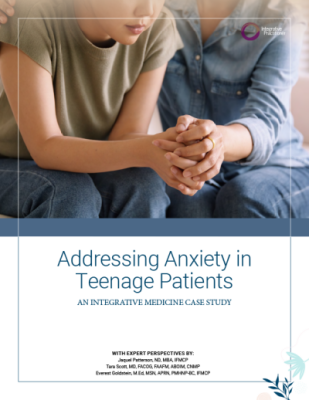Five game-changing policies for integrative healthcare of 2016
December 29, 2016
 Integrative medicine was the focal point of a number of this year’s healthcare policies and regulations. From the opioid crisis to regulating naturopaths, click through to see which five policies from 2016 that we chose to highlight in our end-of-year round-up. Editor’s note: This is the third of a four-part series where IntegrativePractitioner.com will ring in the New Year by looking back at news, policies, trends, and other topics that resonated with our audience in 2016. Check back next Tuesday to see our round-up of this year's top trends.
Integrative medicine was the focal point of a number of this year’s healthcare policies and regulations. From the opioid crisis to regulating naturopaths, click through to see which five policies from 2016 that we chose to highlight in our end-of-year round-up. Editor’s note: This is the third of a four-part series where IntegrativePractitioner.com will ring in the New Year by looking back at news, policies, trends, and other topics that resonated with our audience in 2016. Check back next Tuesday to see our round-up of this year's top trends.  1. Action on pain, opioids and non-pharmacologic approaches National and state policy related to nation’s opioid epidemic continue throughout 2016. In February, the proposed Obama budget includes $1.1 billion for a campaign that is notably absent of reference to non-pharmacologic and integrative approaches. The CDC Guideline for Prescribing Opioids for Chronic Pain earned a letter of support from the American Chiropractic Association (ACA), commending the agency for recommending the use of conservative forms of pain management as an initial treatment option. The Integrative Healthcare Policy Consortium (IHPC) also responded to the CDC draft. They referenced the strong Joint Commission language on non-pharmacologic approaches. They cite the policy brief developed for PAINS through the Academic Collaborative for Integrative Health, Never Only Opioids. State medical societies are weighing in split on the topic. The Massachusetts Medical Society guidelines don’t include a whisper on alternatives to pharma. Yet, denial of the evidence continues. The American Hospital Association’s Hospitals and Health Networks is as dismissive of the non-pharma literature in this review article. Better news came out of an interprofessional group in Minnesota. Organizations representing medical doctors, nurses and pharmacists announced a Joint Statement on Pain Management. One recommendation is to “collaborate using a multi-disciplinary approach to identify all treatment options including pharmacologic and non-pharmacologic modalities.” Read it again: https://www.integrativepractitioner.com/whats-new/news-and-commentary/integrative-health-policy-shorts-february-2016/
1. Action on pain, opioids and non-pharmacologic approaches National and state policy related to nation’s opioid epidemic continue throughout 2016. In February, the proposed Obama budget includes $1.1 billion for a campaign that is notably absent of reference to non-pharmacologic and integrative approaches. The CDC Guideline for Prescribing Opioids for Chronic Pain earned a letter of support from the American Chiropractic Association (ACA), commending the agency for recommending the use of conservative forms of pain management as an initial treatment option. The Integrative Healthcare Policy Consortium (IHPC) also responded to the CDC draft. They referenced the strong Joint Commission language on non-pharmacologic approaches. They cite the policy brief developed for PAINS through the Academic Collaborative for Integrative Health, Never Only Opioids. State medical societies are weighing in split on the topic. The Massachusetts Medical Society guidelines don’t include a whisper on alternatives to pharma. Yet, denial of the evidence continues. The American Hospital Association’s Hospitals and Health Networks is as dismissive of the non-pharma literature in this review article. Better news came out of an interprofessional group in Minnesota. Organizations representing medical doctors, nurses and pharmacists announced a Joint Statement on Pain Management. One recommendation is to “collaborate using a multi-disciplinary approach to identify all treatment options including pharmacologic and non-pharmacologic modalities.” Read it again: https://www.integrativepractitioner.com/whats-new/news-and-commentary/integrative-health-policy-shorts-february-2016/  2. Integrative treatments for back and spine conditions Oregon is the first jurisdiction in the U.S. to adopt a policy offering non-pharmacologic, integrative approaches as a first option for those seeking to manage pain conditions. The Oregon Health Authority (OHA) had previously accepted naturopathic physicians as leaders of their version of a PCMH called a Coordinated Care Organization. Beginning July 1, 2016, the OHA—following recommendation from the state’s multidisciplinary Health Evidence Review Commission panel—began including covered services of acupuncturists and chiropractic doctors. Though the focus was back pain, more common non-pharmacologic approaches, such as cognitive behavioral therapy and physical therapy, were also included. Click here for a fact sheet. Read it again: https://www.integrativepractitioner.com/whats-new/news-and-commentary/oregon-integrative-collaborative-preps-stakeholders-historic-medicaid-painopioids-program/
2. Integrative treatments for back and spine conditions Oregon is the first jurisdiction in the U.S. to adopt a policy offering non-pharmacologic, integrative approaches as a first option for those seeking to manage pain conditions. The Oregon Health Authority (OHA) had previously accepted naturopathic physicians as leaders of their version of a PCMH called a Coordinated Care Organization. Beginning July 1, 2016, the OHA—following recommendation from the state’s multidisciplinary Health Evidence Review Commission panel—began including covered services of acupuncturists and chiropractic doctors. Though the focus was back pain, more common non-pharmacologic approaches, such as cognitive behavioral therapy and physical therapy, were also included. Click here for a fact sheet. Read it again: https://www.integrativepractitioner.com/whats-new/news-and-commentary/oregon-integrative-collaborative-preps-stakeholders-historic-medicaid-painopioids-program/  3. Obstetricians soften views on midwifery and homebirth The anti-homebirth vehemence of the American Congress of Obstetricians and Gynecologists (ACOG) may partly explain why midwifery is rarely included as part of the dialogue around integrative health and medicine. This distance is despite the alignment of the principles and practice of midwifery with core integrative values: respecting the whole person; affirming natural process; the patient-centered right to choose. Recent actions from ACOG suggest that finally a thaw is beginning. The changes are itemized in a e-newsletter from the National Association for Certified Professional Midwives (NACPM). The title features the most recent action: “ACOG Issues Revised Opinion on Home Birth.” ACOG’s updated Committee Opinion on Planned Home Birth reiterates the ACOG perspective that out of hospital births are safest in birth centers. But the changes add that “each woman has the right to make a medically informed decision about delivery.” Read it again: https://www.integrativepractitioner.com/whats-new/news-and-commentary/obstetricians-soften-views-on-midwifery-and-homebirth/
3. Obstetricians soften views on midwifery and homebirth The anti-homebirth vehemence of the American Congress of Obstetricians and Gynecologists (ACOG) may partly explain why midwifery is rarely included as part of the dialogue around integrative health and medicine. This distance is despite the alignment of the principles and practice of midwifery with core integrative values: respecting the whole person; affirming natural process; the patient-centered right to choose. Recent actions from ACOG suggest that finally a thaw is beginning. The changes are itemized in a e-newsletter from the National Association for Certified Professional Midwives (NACPM). The title features the most recent action: “ACOG Issues Revised Opinion on Home Birth.” ACOG’s updated Committee Opinion on Planned Home Birth reiterates the ACOG perspective that out of hospital births are safest in birth centers. But the changes add that “each woman has the right to make a medically informed decision about delivery.” Read it again: https://www.integrativepractitioner.com/whats-new/news-and-commentary/obstetricians-soften-views-on-midwifery-and-homebirth/  4. Pennsylvania regulates naturopathic doctors In a rare win for the naturopathic physicians, in early November, the Pennsylvania Governor Tom Wolf ended a 16-year battle for recognition in the state by signing a law to regulate the profession. In a release from the Association of Accredited Naturopathic Medical Colleges (AANMC), the legislative chair for the Pennsylvania Association of Naturopathic Physicians (PANP), Heidi Weinhold, ND said the governor’s approval will throw open the doors for more Pennsylvania students to choose this academic course of study. “Then, they can return home from a four-year graduate program to set up a practice as a naturopathic doctor,” she said. “This is a historic day for naturopathic medicine.” Read it again: https://www.integrativepractitioner.com/whats-new/news-and-commentary/breaking-ama-logjam-pennsylvania-regulates-naturopathic-doctors/
4. Pennsylvania regulates naturopathic doctors In a rare win for the naturopathic physicians, in early November, the Pennsylvania Governor Tom Wolf ended a 16-year battle for recognition in the state by signing a law to regulate the profession. In a release from the Association of Accredited Naturopathic Medical Colleges (AANMC), the legislative chair for the Pennsylvania Association of Naturopathic Physicians (PANP), Heidi Weinhold, ND said the governor’s approval will throw open the doors for more Pennsylvania students to choose this academic course of study. “Then, they can return home from a four-year graduate program to set up a practice as a naturopathic doctor,” she said. “This is a historic day for naturopathic medicine.” Read it again: https://www.integrativepractitioner.com/whats-new/news-and-commentary/breaking-ama-logjam-pennsylvania-regulates-naturopathic-doctors/  5. AIHM and European anthroposophic group announce “Stuttgart Declaration on Integrative Health and Medicine” Perhaps the most significant policy related move grew out of the Academy of Integrative Health and Medicine’s (AIHM) first global foray, the June 2016 integrative conference in Stuttgart that drew 650 practitioners. Among those presenting was Zhang Qi, MD, who heads the World Health Organization’s (WHO) traditional medicine strategy, and parallel leaders from the Pan American Health Organization. At the meeting, AIHM’s director of education Tabatha Parker, ND and others announced a historic Stuttgart Declaration on Integrative Health and Medicine. The document called on government agencies and non-governmental organizations, such as the WHO, to adopt and promote an integrative model. A petition at Change.org gathered 6,355 signatures by November 6, 2016. This was part of a global connectivity that AIHM leaders initiated through attendance at the WHO General Assembly. Read it again: https://www.integrativepractitioner.com/whats-new/news-and-commentary/aihms-steps-toward-becoming-interprofessional-big-tent-integrative-health/ Resolve to get involved with IntegrativePractitioner.com! We at IntegrativePractitioner.com aim to support the wide spectrum of integrative healthcare professionals in becoming more successful in their practices to effect positive improvements in the current standards of healthcare, policy, and to strengthen the common ground among all constituents. Our site is the destination for business networking relationships among companies and practitioners. Want to get more involved with our community in 2017? Here are a few ways you can make that resolution happen:
5. AIHM and European anthroposophic group announce “Stuttgart Declaration on Integrative Health and Medicine” Perhaps the most significant policy related move grew out of the Academy of Integrative Health and Medicine’s (AIHM) first global foray, the June 2016 integrative conference in Stuttgart that drew 650 practitioners. Among those presenting was Zhang Qi, MD, who heads the World Health Organization’s (WHO) traditional medicine strategy, and parallel leaders from the Pan American Health Organization. At the meeting, AIHM’s director of education Tabatha Parker, ND and others announced a historic Stuttgart Declaration on Integrative Health and Medicine. The document called on government agencies and non-governmental organizations, such as the WHO, to adopt and promote an integrative model. A petition at Change.org gathered 6,355 signatures by November 6, 2016. This was part of a global connectivity that AIHM leaders initiated through attendance at the WHO General Assembly. Read it again: https://www.integrativepractitioner.com/whats-new/news-and-commentary/aihms-steps-toward-becoming-interprofessional-big-tent-integrative-health/ Resolve to get involved with IntegrativePractitioner.com! We at IntegrativePractitioner.com aim to support the wide spectrum of integrative healthcare professionals in becoming more successful in their practices to effect positive improvements in the current standards of healthcare, policy, and to strengthen the common ground among all constituents. Our site is the destination for business networking relationships among companies and practitioners. Want to get more involved with our community in 2017? Here are a few ways you can make that resolution happen: - Submit your content. IntegrativePractitioner.com is currently accepting content from those who are interested in distributing relevant published research or articles to our audience. E-mail [email protected] for more information.
- Join our social media. Engage with your peers in integrative medicine through our informal networking platform via LinkedIn. Click here to become a member. Check us out on Facebook and Twitter, too. We encourage you to ask questions and communicate with us through all of our social media channels.
- Sign up for our newsletter. Stay up to date with all news, commentary, and other tools we have to offer in this weekly e-mail. Click here to subscribe.




















SHARE